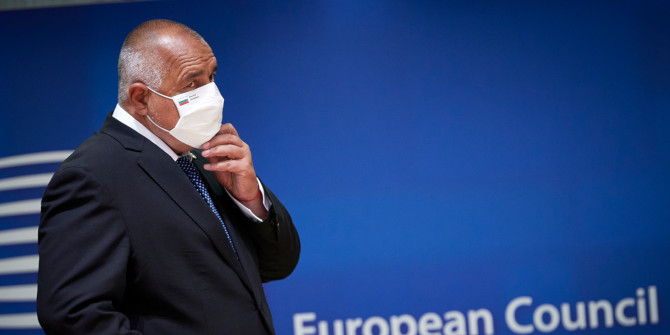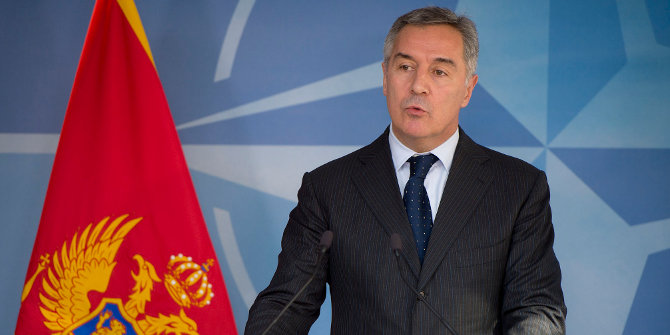The EU has held discussions with Tunisia over a potential deal to reduce irregular migration in the Mediterranean. Sarah Wolff and Florian Trauner argue that while the proposed deal might well reduce the number of arrivals in Europe, it could come at a steep price for human rights.
Earlier this month, EU leaders rushed to pay a visit to Tunisian President Kais Saied. Their aim was not to remind him of the necessity to end his authoritarian rule, but rather to broker a deal on migration. In exchange for one billion euros, Tunisia is now supposed to become a new border guard for the EU.
Although President Saied reassured his domestic audience that the country would not be playing this role, he has few options at his disposal. The economic situation in Tunisia is serious, with a public debt of 80% of GDP and spiralling inflation. The Fitch credit ratings agency recently downgraded Tunisia to a CCC- rating, indicating that it considers the country to have a high risk of defaulting on its debt obligations.
The push for a migration deal reflects a broader change in the EU’s mindset on asylum. Increasingly seen as their Achilles heel in an intensifying geopolitical contest, EU member states now favour fencing off access to asylum seekers via fast-track border procedures and externalising protection duties. Contested deals with third countries, many of which are characterised by a dire human rights situation, are part of this wider picture. The generous temporary protection offered to Ukrainians remains an exception in an asylum regime where the rights of asylum seekers are shrinking.
An efficient tool?
The rationale behind the proposed EU-Tunisia deal on migration is far from new. Nor is this the first time the EU has sought agreements with authoritarian leaders around the Mediterranean. The most famous of these is the EU-Turkey deal of 2016, when the EU agreed to provide financial assistance and resettle one registered Syrian refugee in exchange for every Syrian refugee returned back to Turkey.
The deal, which was renewed in 2020, has been deemed efficient by EU member states. The figures speak for themselves: while the number of sea arrivals from Turkey to Greece hit 856,723 in 2015, this fell to just 29,718 in 2017 and, despite a rise in 2019, was as low as 12,758 in 2022. Alongside the EU-Turkey deal, the EU endorsed a bilateral memorandum of understanding between Italy and Libya in 2017. There are also several informal bilateral agreements between EU member states and neighbouring countries.
Despite this, overall flows to the EU have not stopped in the Mediterranean. They still reached 159,410 arrivals in 2022, with other parts of the Mediterranean becoming more relevant arrival areas. Italy now sees more migrants than Greece. There is ample evidence that more surveillance of coastlines and the sea simply leads to a redirection of migratory routes. Migrants continue to be eager to seek safety or opportunities in Europe.
Ukraine and the EU’s two-tier asylum system
The unscrupulous attempt to fence off the EU’s southern border is at odds with the EU’s generous policy toward Ukrainian refugees. Following Russia’s invasion of Ukraine in February 2022, the EU rapidly activated its Temporary Protection Directive. This tool, which had never been used before, has provided a temporary protection regime for Ukrainians with the aim of preventing the collapse of the EU’s Common European Asylum System, which would never have been able to cope with the arrival and processing of an estimated 4.8 million new refugees to Europe.
The Temporary Protection Directive has the advantage of offering Ukrainians protection as a group instead of processing every asylum application individually. The EU’s handling of Ukrainians is not without challenges, such as incorporating new arrivals into the labour market, but many observers have highlighted the pragmatism of the EU in coordinating this response swiftly.
The fact that Ukrainians were direct neighbours fleeing a conflict has ensured EU unity on several fronts. This is in stark contrast to the approach to the Mediterranean states, which are often transit countries for migrants from conflicts further away. We are now seeing a highly different and diverging response to the refugee challenges on the EU’s eastern and southern borders. The EU has essentially established a two-tier system that relies to some extent on preselection when determining who is entitled to protection.
EU consensus-building around emergency practices
The proposed EU-Tunisia deal cannot be understood in isolation. It forms an integral part of efforts by the EU’s member states to reform the Common European Asylum System. In doing so, the European Council has prioritised stricter and swifter asylum procedures, enhanced measures to detain migrants and higher return rates.
EU member states that refuse to accept asylum seekers will be obliged to show solidarity through other means, such as financially contributing to EU migration management. This helps explain the willingness of the EU to send back migrants to countries with which they have links, however superficial. Member states will get full sovereignty to decide which third country is ‘safe’ for a returned migrant.
These reforms are mainstreaming practices that some member states have been using for several years. Earlier this year, for instance, Italy announced a state of emergency on migration that effectively reduces the rights of migrants. The European Commission’s response to this and other contested practices in relation to migration has been notably weak in comparison to the criticism it expressed of Hungary’s response to the 2015 Syrian refugee crisis.
Latvia, Lithuania and Poland also implemented emergency laws and erected border fences in the summer of 2021 as a response to increased flows of people from Belarus. These laws are still in place and have been prolonged due to Russia’s war on Ukraine. While the Commission has been critical of attempts to pushback people into Belarus, it has not initiated any infringement procedures over the situation, as it did with Hungary.
All of this means that asylum rights in the EU increasingly depend on the political will of the member states. Many EU leaders now view asylum as a geopolitical risk through which third countries can exert pressure on the EU. This explains the EU’s focus on its southern neighbourhood. Deals such as the proposed agreement with Tunisia risk leaving migrants stuck in countries that treat them inhumanely. The EU’s approach may have an impact in reducing arrivals to Europe, but this could come at a steep price for human rights.
Note: This article gives the views of the authors, not the position of EUROPP – European Politics and Policy or the London School of Economics. Featured image credit: © European Union, 2023




